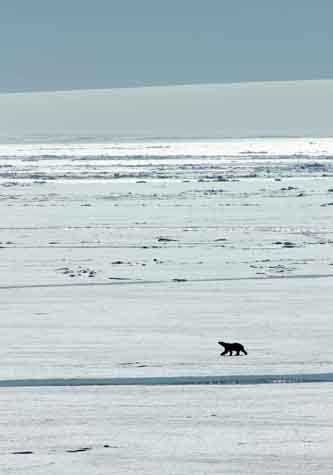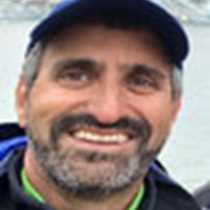We awoke above 80° north latitude in the remote northeastern reaches of the Svalbard Archipelago, a region rarely visited and barely acknowledged on maps. National Geographic Explorer maneuvered through jumbled ice floes on approach to Storøya ("Big Island"), an impressive dome of ice rising from the Arctic Ocean. Here in this frozen netherland beyond the warming influence of the Gulf Stream, the land masses are almost completely covered by glacial ice, relics of the world during ice ages.
In stark contrast to the cold, forbidding, icy reputation of the Arctic, we were treated to a bright, sunny, clear morning and light airs for Zodiac cruises along Storøya’s northern bays. Arctic terns, those daylight-loving champion migrators, fished about us as we peered into clear aquarium shallows. In the far distance icebergs morphed from anvils to pyramids to spaceships through the high latitude miraging of Fata Morgana. Beside us, grounded multi-year ice forms with arches, mushroom tops and submerged aquamarine feet presented Rorschach imaginings.
Farther pole-ward into the frozen wastes of the Arctic Ocean, our dedicated spotters discovered more polar bears. One ice bear swam impressively and steadily from a large floe to the larger frozen sheet of ocean before us. The bear, not averse to getting wet, swam up a tight lead in the ice, then continued on foot eastward, before detecting the upwind scent of another bear and redirecting its course. The two bears converged, one moving off its meal to avoid conflict and socialization with the new arrival. As the ship continued through pack and floe, our resident polar bear expert Stefan Lundgren shared his experiences and winning photographs of this quintessential polar animal.
Off to the east, appearing like an apparition through a distant purple fog band, rose the white ice dome of Kvitøya ("White Island"). Famed author, cultural anthropologist, historian, and scientist Jared Diamond, this voyage’s Global Perspectives guest speaker, presented a fascinating chapter of polar exploration that ended tragically right here on Svalbard’s remote Kvitøya. Professor Diamond told us of the Swede Salomon Andree’s attempt at the North Pole by hydrogen balloon in 1897, interspersing perspectives on leadership and the metaphorical appeal of exploration stories. Lessons from ventures in extreme environments magnify life itself and teach us the importance of possessing abilities and being prepared against potential challenges—important perspectives we can appreciate on this voyage aboard National Geographic Explorer in such an extreme place on our planet.
As the evening sun didn’t set, we traveled along the hundred-mile glacial coastline of Nordaustlandet, back towards western Svalbard.







